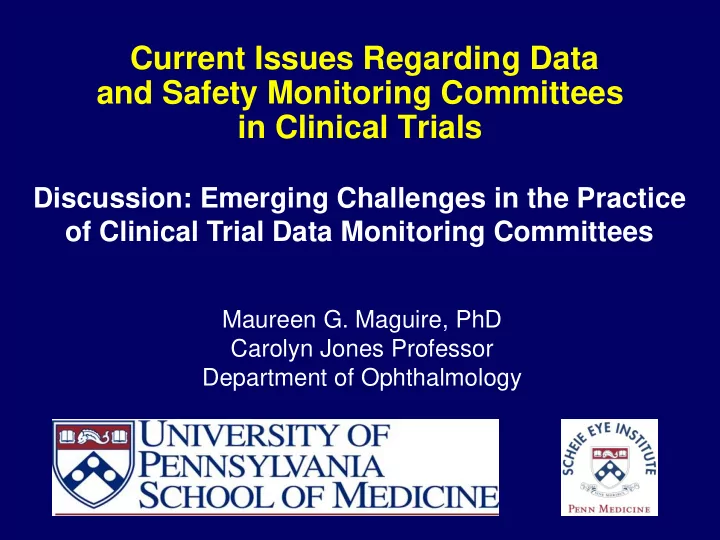

Current Issues Regarding Data and Safety Monitoring Committees in Clinical Trials Discussion: Emerging Challenges in the Practice of Clinical Trial Data Monitoring Committees Maureen G. Maguire, PhD Carolyn Jones Professor Department of Ophthalmology 1
Best Practices Mission of the DMC Safeguard the interest of study participants Preserve trial integrity and credibility Fundamental Principle: DMC should have Sole Access to interim results on relative efficacy & relative safety of interventions 2
Consent Form Language Required elements of consent forms [21 CFR 50.25(b)] What if new information becomes available about the study? “ During the course of this study, we may find more information that could be important to you. This includes information that, once learned, might cause you to change your mind about being in the study. We will notify you as soon as possible if such information becomes available .” 3
Example 1 - 2016 Drug X has been tested in >10 multicenter RCTs involving thousands of patients and is FDA-approved for a number indications. There are theoretical reasons to believe that Drug X may cause specific serious adverse events. Preceding trials have had mixed results. Informed consent for “New Trial” for a new condition indicates theoretical risk and mixed results. Ongoing New Trial is relatively small, ~ 200 per arm. More events with Drug X (RR =2; p=0.11). 4
Example 1 - 2016 DSMC recommends No change in protocol New Trial patients be told of higher rate with Drug X. 5
Example 1 - 2016 DSMC recommends No change in protocol New Trial patients be told of higher rate with Drug X. Is this consistent with Safeguarding the interest of study participants? Preserving trial integrity and credibility? DMC having sole access to interim results on relative efficacy & relative safety of intervention? 6
Example 2 - 2017 Agent Y is sold over the counter. Many physicians recommend Agent Y for Condition X, a relatively common ailment. Only a few small RCTS. “NIH Trial” is comparing Agent Y to placebo and is ongoing. Industry-sponsored RCT of Agent Y – results published Modest efficacy and no safety problems. Only 10% of patients in NIH Trial would qualify for this trial 7
Example 2 - 2017 DSMC recommends No change in protocol NIH Trial patients be told of results of the other trial Encourage patients to continue study visits 8
Example 2 - 2017 DSMC recommends No change in protocol NIH Trial patients be told of results of the other trial Encourage patients to continue study visits Is this consistent with Safeguarding the interest of study participants? Preserving trial integrity and credibility? 9
Medical Ethics Pillars of Medical Ethics Autonomy – the patient should come to their own decision Beneficence – promote what is best for the patient Non-maleficence – do no harm Justice – fairness Medical Paternalism - A philosophy that certain health decisions are best left in the hands of others; interferes with autonomy 10
What Would Art Caplan Say? Well known, widely cited bioethicist 2012 “ Autonomy has replaced beneficence and paternalism as the core norms of health care. The dissemination of information to others … [it’s] primary purpose is to permit valid informed choice and, thus, to empower individual self-determination and autonomy .” Caplan A. Enhancing patient autonomy through peer review to replace the FDA's rigorous approval process. Health Affairs 2012; 31:2236-2240. 11
But … Many studies show poor patient understanding of health care information “Information that is not accurate, peer reviewed, comprehensible, comprehensive, trustworthy, verifiable, and transparent is not what patients require to be autonomous.” 12
Back to the Examples The DMC with both safety and efficacy data available, full knowledge of previous studies does not recommend any change. Patients were not provided with interim results on efficacy, are not experts in meta-analysis, etc 13
Summary The examples demonstrate tension between best practices and beliefs on patient autonomy Solutions More training/experience? Indemnification? More formal input from the bioethics community or patients on the DMC process? 14
Recommend
More recommend